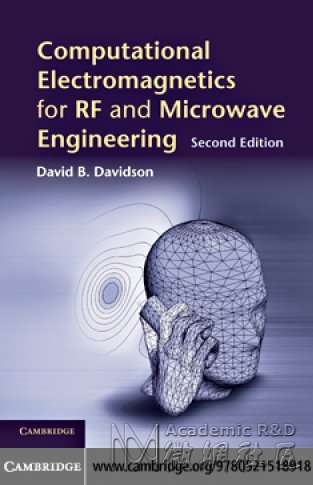Computational Electromagnetics
for RF and Microwave
Engineering
Second Edition
DAVID B. DAVIDSON
Department of Electrical and Electronic Engineering
University of Stellenbosch, South Africa
不知道这里有没有这本书。
这本书翻了一下,大部分是基础内容,或许有人需要

Preface to the second edition page xv
Preface to the first edition xvii
Acknowledgements xxi
To the reader xxiii
List of notation xxiv
1 An overview of computational electromagnetics for RF and microwave
applications 1
1.1 Introduction 1
1.2 Full-wave CEM techniques 3
1.3 The method of moments (MoM) 8
1.4 The finite difference time domain (FDTD) method 10
1.5 The finite element method (FEM) 13
1.6 Other methods 16
1.6.1 Transmission line matrix (TLM) method 16
1.6.2 The method of lines (MoL) 17
1.6.3 The generalized multipole technique (GMT) 17
1.7 The CEM modelling process 17
1.8 Verification and validation 19
1.8.1 An example: a frequency selective surface 20
1.9 Convergence and extrapolation 23
1.10 Extending the limits of full-wave CEM methods 24
1.11 CEM: the future 25
1.12 A “road map” of this book 28
References 29
2 The finite difference time domain method: a one-dimensional introduction 32
David B. Davidson and James T. Aberle
2.1 Introduction 32
2.2 An overview of finite differences 33
2.2.1 Partial differential equations 33
2.2.2 The basic solution procedure 34
2.2.3 Approximating derivatives using finite differences 34
2.3 A very brief history of the FDTD 36
2.4 A one-dimensional introduction to the FDTD 37
2.4.1 A one-dimensional model problem: a lossless transmission line 37
2.4.2 FDTD solution of the one-dimensional lossless transmission line
problem 40
2.4.3 Accuracy, convergence, consistency and stability of the method 46
2.5 Obtaining wideband data using the FDTD 52
2.5.1 The Gaussian pulse 52
2.5.2 The Gaussian derivative pulse 54
2.5.3 A polynomial pulse 54
2.5.4 The 1D transmission line revisited from a wideband perspective 57
2.5.5 Estimating the Fourier transform 60
2.5.6 Simulation using Gaussian and Gaussian derivative pulses 62
2.6 Numerical dispersion in FDTD simulations 64
2.6.1 Dispersion 64
2.6.2 Derivation of the dispersion equation 66
2.6.3 Some closing comments on dispersion in FDTD grids 67
2.7 The Courant stability criterion derived by von Neumann analysis 69
2.8 Conclusion 71
References 71
Problems and assignments 72
3 The finite difference time domain method in two and three dimensions 74
3.1 Introduction 74
3.2 The 2D FDTD algorithm 74
3.2.1 Electromagnetic scattering problems 75
3.2.2 The TEz formulation 75
3.2.3 Including a source: the scattered/total field formulation 79
3.2.4 Meshing the scatterer 81
3.2.5 Absorbing boundary conditions 82
3.2.6 Developing the simulator 84
3.2.7 FDTD analysis of TE scattering from a PEC cylinder 91
3.2.8 Computational aspects 96
3.3 The PML absorbing boundary condition 97
3.3.1 An historical perspective 97
3.3.2 A numerical absorber – pre-Berenger 99
3.3.3 Berenger’s split field PML formulation 101
3.3.4 The FDTD update equations for a PML 102
3.3.5 PML implementation issues 104
3.3.6 Results for a split field PML 105
3.3.7 Drawbacks of the Berenger PML 106
3.3.8 Uniaxial absorber theory 107
3.3.9 Stretched coordinate theory 108
..................................................................
